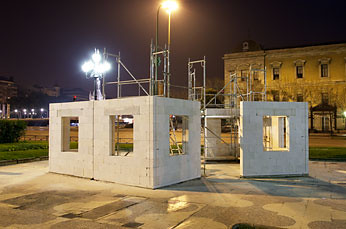“Art does not provide answers or solutions, but is rather a questioning, which should be as clear as possible so that the listeners can look for answers themselves” ((Weiner, Lawerence et al (1998) other rooms other voices Switzerland: Memory cage editions))
I feel like constant questioning and engagement not only makes the audience feel a part of the performance but also provides them with an individual, potential performative experience which only they can be involved in. This experience can then be discussed and shared through dialogue or kept private depending on their approval during or after the performance. What would happen if the audience physically got involved in the communication of language through playing and experimenting with the sounds of a kitchen?


(Weileder, Wolfgang House Projects (2005), http://www.house-projects.com/ (accessed 13th April)
“The interface between space and time defines Wolfgang Weileder’s central field of artistic activity” ((Weileder , Wolfgang (2005) House-Projects Manchester: Cornerhouse publications)) Weileder worked with a range of architectural structures and sites to form a relationship and response to the art he provokes, starts or aids. In House he converses how he provokes discussion and interaction during the performance. In traditional theatre performances audience follow the conventional rule of not talking, this is so the actors do not get distracted and therefore change their actions and words to make the performance different to how it should be, and so, change its overall intention. Intentions of performances are quite limiting and I think the broader you are the more flexible and exciting the art can be to create and to experience. Making a piece different every night moves it from a performance to an experience.
What happens when audiences talk to each other?
The power of discussion will surely enhance the creation and therefore change the initial intention of the piece. The idea of an ephemeral, tangible piece of art is something which excites me as a performer – to know that your idea can change and be interpreted differently depending on the receiver makes the performance have more personalisation and potentially makes it more of an experience for each audience member. Using senses to trigger peoples’ emotions, especially in such a accustomed site would be quite an easy task to do, but putting an audience member in a familiar room with unfamiliar settings and control – this is where their memories may not link so logically. Which would make the experience much more individual, unique and different.
To use a pre-performance audience (due to our limited performance run) as a base to then work with, those memories and connotations could potentially be a path in which would locate and humanise what I am creating. This link to peoples’ lives and own experiences, whether they be domestic or not, will hopefully aid me in my creations but more importantly understand what type of material is surfacing so I can have some creative control in the final performance.
(Mobile Art Production (2011) The role of the audience inside contemporary art and theatre online: http://www.youtube.com/watch?v=-v7bLdISHvE (accessed 1st March 2013)
The video above states the idea of “being inside an artwork”, she discusses an audio experience in which she felt included by someone talking to her through her headphones. The feeling of someone being that close to you in one way, depending on what they are saying, is quite unnerving but I do believe that you, as an audience member, will very rarely challenge their words if it’s an unknown voice, so whether it is realistic or not I strongly believe the element of control is with the sound inside the headphones. This excites me as a creator and potential performer because I feel as if I can pre-determine the outcome and experiment with fiction. Rational and logical thinking disappears when you can’t visually see who you are talking to meaning that the normal conventional conversation rules wouldn’t apply. To provoke an unnatural experience is quite exciting and so by doing this audience members will automatically, due to the context and surroundings be placed temporarily in to an unfamiliar state of mind.
I think it’s the responses which give the audience a chance to delve in to their own individual experience and not the literal performance itself.